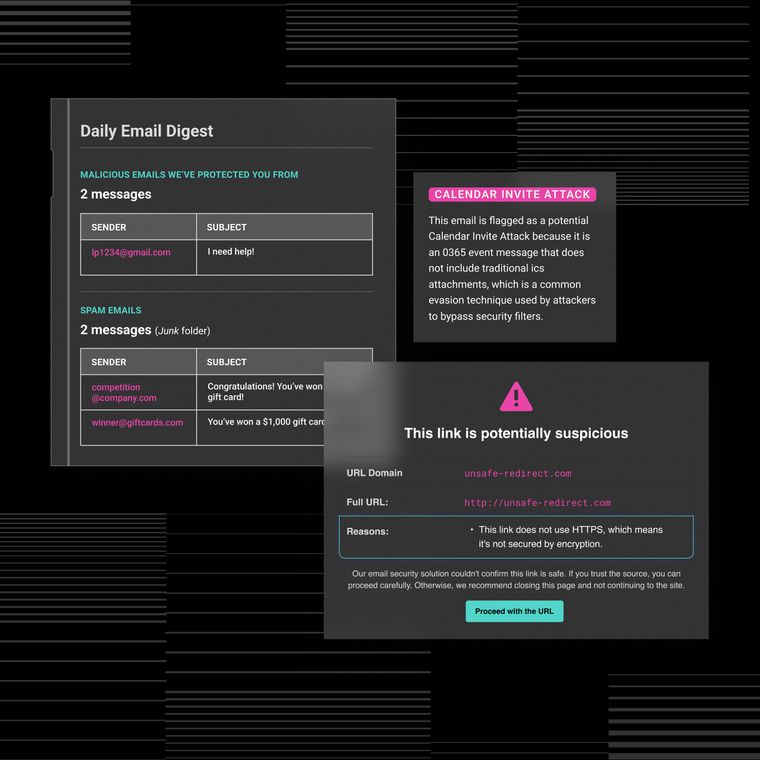How to Building a Stronger Security Posture Management Program
Explore how to strengthen security posture management to reduce vulnerabilities and improve overall resilience.
September 2, 2025
Every Microsoft 365 tenant contains misconfigurations that attackers actively scan for, from legacy authentication protocols and excessive admin privileges to hidden forwarding rules that operate undetected for months. Configuration gaps consistently rank among the top initial access vectors in breach investigations, yet security teams struggle to maintain visibility across Exchange, SharePoint, Teams, and Azure AD settings that change daily.
The challenge intensifies as organizations scale. Each new employee and department expansion adds complexity, while native tools either flood teams with contextless alerts or require time-intensive manual audits that quickly become outdated.
Security Posture Management (SPM) transforms this reactive cycle through continuous monitoring and intelligent prioritization. By correlating configuration changes with threat intelligence, SPM surfaces the modifications that actually increase risk. The following six-step framework shows you how to implement posture management that scales with your environment, automates remediation where possible, and provides the context needed to make informed security decisions.
Here's a jargon-free, CISO-friendly version with internal links:
1. Map Your Current Security Landscape
Complete visibility across your Microsoft 365 environment forms the foundation of effective security. Before implementing new controls, you need to understand what you're protecting and where vulnerabilities exist.
Start by creating a comprehensive inventory of your digital assets. Document every email account, file storage location, collaboration space, connected device, and third-party application. Export this data into a centralized dashboard that shows how employees access resources and where sensitive information resides.
Next, organize your findings into meaningful categories. Label content by department and sensitivity level, identify who owns each workspace, and document what permissions you've granted to external applications. Using an established framework like CIS Controls prevents this from becoming an overwhelming spreadsheet exercise by providing a clear checklist for tracking ownership and remediation steps.
Your discovery isn't complete until you find the forgotten assets. Machine learning tools can uncover abandoned file shares, inactive collaboration channels, and orphaned storage created when employees leave. Including these hidden assets in your inventory ensures forgotten data doesn't become tomorrow's breach.
Finally, map out administrative access across your environment. Document who has elevated privileges, which applications have special permissions, and where access rights may have expanded beyond original intentions. This blueprint becomes your baseline for identifying and addressing security risks.
2. Establish Clear Risk Prioritization Criteria
Not all security gaps pose equal danger to your organization. A systematic approach to risk assessment ensures your team focuses on the vulnerabilities that matter most to your business.
Use the following five practical criteria to guide your decisions:
Business Impact Assessment: Evaluate how each vulnerability could affect your operations by connecting security gaps to specific business functions. A configuration error affecting your intellectual property storage requires immediate action, while minor collaboration tool settings can wait for scheduled updates.
Attack Surface Evaluation: Identify settings that expose your organization to external threats. Internet-facing email configurations, outdated authentication methods, and applications with excessive permissions create easy entry points that attackers actively target.
Regulatory and Data Protection: Focus on risks affecting regulated or confidential information to avoid compliance violations. For instance, healthcare organizations must prioritize gaps affecting patient records, while financial institutions concentrate on protecting transaction data and customer information.
User Behavior Monitoring: Track unusual activity patterns that signal potential insider threats or compromised accounts. Employees suddenly downloading large amounts of data, accessing systems at odd hours, or requesting new permissions warrant immediate investigation.
Critical Operations Dependencies: Address vulnerabilities in systems essential to daily operations first. Problems affecting email, document management, or employee authentication create company-wide exposure that compounds other risks.
Certain misconfigurations consistently appear in breach investigations: missing multifactor authentication, outdated authentication methods, and excessive administrative privileges. These proven attack vectors deserve your immediate attention.
3. Integrate Continuous Monitoring
Real-time visibility into your Microsoft 365 environment reveals security changes as they happen, not months later during an audit. Modern monitoring tools track every new email rule, permission change, and login attempt automatically.
Continuous monitoring delivers four essential benefits:
Instant Change Detection: Your environment evolves constantly as employees adjust settings and administrators deploy features. Real-time tracking catches these changes immediately, letting you reverse problematic modifications before attackers exploit them, such as when someone accidentally makes confidential files publicly accessible.
Faster Threat Response: Ransomware can encrypt files within hours while phishing attacks steal credentials in minutes. Continuous monitoring connects suspicious activities across email, file access, and user behavior, alerting you when unusual login patterns combine with mass downloads and new forwarding rules.
Automated Compliance Documentation: Regulations require proof of ongoing security controls, not just annual assessments. Automated monitoring creates detailed logs of every configuration change and access attempt, eliminating last-minute scrambles to prepare audit documentation.
Behavioral Insight: While configuration reviews show what's possible, behavioral analytics reveal what's actually happening. Monitoring detects unusual access patterns, bulk data transfers, and privilege changes that indicate compromised accounts or malicious insiders.
Modern monitoring tools connect directly to Microsoft 365 without requiring software installation or system downtime. They collect standard activity logs, then apply intelligent analysis to identify genuine risks among routine events.
4. Automate Remediation Where Possible
Automation accelerates threat response while reducing your security team's workload. Microsoft 365 offers built-in capabilities to automatically enforce security policies, disable risky features, and correct dangerous settings.
Start automation with straightforward, repetitive tasks that have clear solutions. Roll out changes gradually with testing phases to avoid business disruption. Keep human oversight for critical decisions to catch potential problems before they affect operations. Document every automated process to maintain transparency and provide manual alternatives when needed.
Practical Automation Examples
Focus on scenarios where automation improves security without hampering productivity. Schedule regular permission reviews that automatically remove unnecessary access rights, ensuring privileges align with current job responsibilities. Deploy multifactor authentication through automated policies that guide users through setup while enforcing compliance.
Balance security automation with business needs carefully. Time non-urgent fixes during maintenance windows, test major changes with pilot groups first, and always maintain manual override options for emergencies. This measured approach ensures security improvements enhance rather than disrupt operations.
5. Incorporate Behavioral Intelligence
Behavioral intelligence identifies subtle attack patterns that traditional security rules miss. By learning how your employees typically work and flagging unusual activities, you shift from reacting to incidents to preventing them.
Standard security rules can't catch sophisticated attacks that mimic legitimate activity. Advanced platforms analyze patterns across logins, file access, and email usage to identify actions that appear normal but deviate from established behavior. When someone bypasses security controls or creates suspicious email rules, behavioral analysis provides context-aware alerts before data exfiltration occurs.
Red Flags That Demand Attention
Watch for these warning signs: logins from unusual locations or impossible travel scenarios, sudden increases in file downloads or after-hours sharing, new email rules that forward messages externally, and administrative actions by users who rarely need elevated access.
Machine learning identifies these patterns across thousands of users simultaneously. The technology establishes normal behavior baselines for every employee, then scores deviations in real time. While a single unusual login might be harmless, that same event followed by mass file downloads and new email permissions creates an escalating risk profile requiring immediate attention.
These systems adapt as your organization evolves, reducing false alarms while catching sophisticated threats. Connecting behavioral insights to automated responses enables immediate action like restricting access or disabling suspicious features without manual intervention.
6. Measure, Report, and Improve Continuously
Demonstrating security progress requires clear metrics that prove value and guide improvements. Track four essential indicators: reduction in critical vulnerabilities, speed of threat response, security score improvements, and compliance readiness percentage.
Automate metric collection through integration with your existing security tools. Dashboard platforms organize findings by severity for executive presentations, while risk-based analysis shows whether you're addressing the most dangerous issues first, including missing MFA, outdated authentication, and excessive privileges.
Schedule monthly metric reviews and quarterly deep-dive assessments. Connect results to business outcomes: operational continuity, regulatory compliance, and customer trust. When progress stalls, identify process bottlenecks, adjust automation rules or training programs, then measure improvement.
Consistent measurement and transparent reporting create a continuous improvement cycle. This feedback loop progressively strengthens your security posture while demonstrating tangible value to leadership and stakeholders.
Strengthen Microsoft 365 Security With Modern Approaches
Implementing a structured approach in Microsoft 365 environments significantly enhances your defense strategy while reducing vulnerabilities across your tenant. Each of the six steps works together to create comprehensive protection against configuration-based threats.
For instance, a cybersecurity training organization recently discovered that a single misconfigured forwarding rule had exposed 28,000 user records over an entire month. After an employee responded to a phishing attack, attackers modified email settings to silently forward 500 internal emails and thousands of records to an external account. Despite having security expertise and quarterly audits, this configuration change operated undetected between review cycles: a gap that traditional monitoring failed to close.
This incident represents a common challenge organizations face. Native Microsoft 365 tools generate numerous alerts without prioritizing critical changes. Manual audits create visibility windows that attackers exploit. Split responsibilities across teams result in configuration drift that no single group fully monitors.
There's a reason why organizations are moving beyond manual configuration reviews to address Microsoft 365 security challenges. Modern operations require continuous visibility, automated response, and behavioral intelligence that adapts to your unique environment.
Abnormal's Security Posture Management transforms how organizations protect Microsoft 365 configurations. Through API-based integration, the platform continuously assesses settings against CIS benchmarks and threat intelligence from across our customer base. When risky changes occur, whether an admin modifies conditional access policies or an attacker creates forwarding rules, teams receive immediate alerts with step-by-step remediation guidance. This approach replaces reactive quarterly audits with proactive, continuous protection that scales with your environment.
Ready to transform your Security Posture Management with AI-driven protection? Get a demo to see how Abnormal can strengthen your Microsoft 365 defenses against sophisticated threats that exploit configuration weaknesses.
Related Posts
Get the Latest Email Security Insights
Subscribe to our newsletter to receive updates on the latest attacks and new trends in the email threat landscape.


